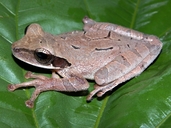|
Osteocephalus castaneicola Moravec, Aparicio, Guerrero-Reinhard, Calderón, Jungfer & Gvozdík, 2009
| family: Hylidae subfamily: Hylinae genus: Osteocephalus |
| Species Description: Moravec J, Aparicio J, Guerrero-Reinhard M, Calderon G, Jungfer K-H, Gvozdik V. 2009 A new species of Osteocephalus (Anura: Hylidae) from Amazonian Bolivia: first evidence of tree frog breeding in fruit capsules of the Brazil nut tree. Zootaxa 2215:37- 54 | |
 © 2009 Dr. Jiri Moravec (1 of 4) |
|
|
|
Description Description: Adult males measure 47.8-51.3 mm SVL. Adult females measure 47.7-63.3 mm SVL. Head slightly longer than wide. Snout rounded with distinct medially curved canthus rostralis, concave loreal region and slightly depressed internarial region. Nostrils are slightly protuberant. Eyes are large and quite protuberant. Frontoparietal ridges are present. Large rounded tympanum with distinct annular ring and a well-developed supratympanic fold obscuring the dorsal edge of the tympanum. Vomerine ridges are angular, large and prominent with 6-14 teeth each. Tongue ovoid and widely attached to bottom of mouth. Arms are slender. No axillary membrane is present. Forearm has small low tubercles on the ventrolateral edge. Fingers are basally webbed and have expanded oval discs. Finger III disc width equals about half the diameter of the tympanum. Subarticular tubercles are single, and round. Supernumerary tubercles are present. Palmar tubercle is large and flat. Prepollical tubercle is elliptical and flattened. Legs are moderately long and slender. Heels overlap when limbs are adpressed. Toes are moderately long with oval discs, and are three-fourths webbed. Toe discs are slightly smaller than finger discs. Subarticular tubercles are single, protuberant, and rounded; supernumerary tubercles are also present. Tibiotarsal articulation has small raised tubercles on the outer edge. Posterior surface of proximal third of thigh has rounded tubercles. Ventrolateral edge of foot has small low tubercles. Outer metatarsal tubercle is distinct, round, and small; inner metatarsal tubercle is large and ovoid. Short cloacal sheath present. Vent surrounded by rounded tubercles. Skin on dorsum, head, and dorsal limbs with minute tubercles. Flanks are shagreened. Venter has coarse granulation. Males lack vocal slits and have an indistinct vocal sac. Nuptial pads are dark and keratinous and are confined to the enlarged prepollex (Moravec et al. 2009). Coloration is pale brown to purplish-brown with occasional irregular dark brown markings. A light narrow stripe runs on the upper lip, expanding into a spot underneath the eye. A dark narrow stripe runs along the lower jaw. Throat and belly are creamy white. Flanks are light colored. Hidden surfaces of thighs are light brown and the undersurfaces of the thighs are fleshy pink. Tibiae are green or white. Iris has fine dark reticulation over a golden upper half, a dark medial stripe, and a bronze lower half (Moravec et al. 2009). Newly metamorphosed juveniles are light brown with a dark interorbital spot. Bright orange iris. Upper arms, knees and heels are creamy white. (Moravec et al. 2009). Distribution and Habitat Country distribution from AmphibiaWeb's database: Bolivia, Peru
Life History, Abundance, Activity, and Special Behaviors This species represents the first hylid known to use Brazil nut fruit capsules for breeding. Other frog species using these capsules for breeding include Dendrobates castaneoticus (a dendrobatid), Dendrobates quinquevittatus (also a dendrobatid), and Bufo castaneotica (a bufonid) (Caldwell 1993; Lötters et al. 2007). Like O. castaneicola, B. castaneotica also occasionally makes use of alternative breeding sites, namely small water-filled holes in the soil (Köhler and Lötters 1999). Comments
References
Caldwell, J. P. (1993). ''Brazil nut fruit capsules as phytotelmata: Interactions among anuran and insect larvae.'' Canadian Journal of Zoology, Köhler, J. and Lötters, S. (1999). ''Annotated list of amphibian records from the Departamento Pando, Bolivia, with description of some advertisement calls.'' Bonner zoologische Beiträge, 48, 259-273. Lötters, S., Jungfer, K.-H., Henkel, F. W. and Schmidt, W. (2007). Poison Frogs. Biology, Species & Captive Husbandry. Edition Chimaira, Frankfurt am Main. Moravec, J., Aparicio, J., Guerrero-Reinhard, M., Calderon, G., Jungfer, K., and Gvozdik, V. (2009). ''A new species of Osteocephalus (Anura: Hylidae) from Amazonian Bolivia: first evidence of tree frog breeding in fruit capsules of the Brazil nut tree.'' Zootaxa, 2215, 37-54. Von May, R., Jacobs, J. M., Jennings, R.D., Catenazzi, A. and Rodríguez, L. O. (2007). Anfibios de Los Amigos, Manu y Tambopata, Perú. Rapid Color Guide #236 versión 1. . Environmental & Conservation Programs, The Field Museum, Chicago. Originally submitted by: Stephanie Ung (first posted 2009-09-14) Edited by: Kellie Whittaker (2010-05-19) Species Account Citation: AmphibiaWeb 2010 Osteocephalus castaneicola <https://amphibiaweb.org/species/7374> University of California, Berkeley, CA, USA. Accessed Dec 26, 2024.
Feedback or comments about this page.
Citation: AmphibiaWeb. 2024. <https://amphibiaweb.org> University of California, Berkeley, CA, USA. Accessed 26 Dec 2024. AmphibiaWeb's policy on data use. |




 Map of Life
Map of Life